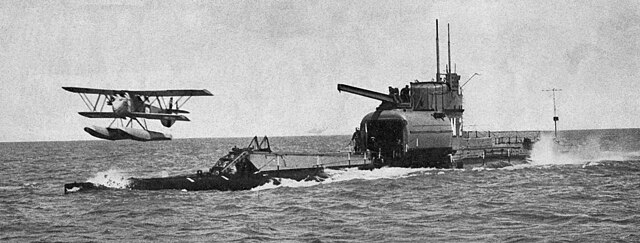By: Aviation Co.
Once thought to be a futuristic fusion of stealth and firepower, submarine aircraft carriers have largely faded into obscurity since their experimental beginnings in the 1930s and ’40s. But as defense strategies evolve in 2025, some are beginning to ask: Could these hidden giants of naval warfare make a comeback?
Here we’ll explore the origins of submarine aircraft carriers, highlight key experiments by Japan, the U.S., and the Soviet Union, and examine why the concept faded from use. We’ll also look at how advances in drone technology, stealth capabilities, and underwater warfare in 2025 are reviving interest in this once-forgotten naval innovation.
A Brief Dive into History
Perhaps the most famous example was Japan’s I-400 class submarine, also known as the Sen Toku class, developed during World War II (WWII) by the Imperial Japanese Navy (IJN). These Japanese submarines were capable of carrying and launching specially designed aircraft from a hangar located on the deck. The goal? Surprise attacks on distant targets—such as a planned strike on the Panama Canal that never materialized before the end of the war.
At the time, the I-400s were the largest submarines ever built, designed to transport multiple aircraft across the Pacific. Each could carry three Seiran floatplanes in a watertight hangar, launching them via a compressed-air catapult. While technologically impressive, the concept proved too advanced for the era and faced major logistical challenges.
Unlike the nuclear-powered submarines of today, these early submarine aircraft carriers were diesel-electric and limited in range. None saw meaningful combat before Japan’s surrender in 1945.
Cold War Experiments: Regulus and Soviet Designs
During the Cold War, both the United States and the Soviet Union explored the idea of launching aircraft—or at least missiles—from submarines. The U.S. Navy briefly deployed the Regulus cruise missile system, which required a submarine to surface and assemble a missile on deck. Though not a true aircraft carrier, this was an evolutionary step that borrowed from the same concept: deploying long-range attack systems from underwater platforms.
Meanwhile, the Soviet Navy explored similar ideas, including designs that would enable vertical takeoff and landing (VTOL) aircraft to operate from submerged platforms, but none progressed beyond the blueprint stage.
Why Submarine Aircraft Carriers Faded Away
Despite the initial promise, the submarine aircraft carrier was ultimately set aside in favor of more effective and reliable systems. Traditional aircraft carriers offered far greater capacity, flexibility, and airpower. Submarines, meanwhile, proved better suited to stealth attacks, missile delivery, and reconnaissance. The technology to combine these missions simply wasn’t mature enough—especially when factoring in the limited size of hangars, aircraft development constraints, and the complexity of underwater aircraft launch systems.
Could 2025 Change the Equation?
While traditional naval power has long centered on surface ships, such as battleships, a modern strategy increasingly emphasizes stealth and versatility beneath the surface. With recent advances in autonomous drones, miniaturized systems, and stealth technology, some military strategists are re-evaluating the idea. Today’s UAVs (unmanned aerial vehicles) are lighter, more compact, and require less runway space—making them theoretically more compatible with submerged platforms.
Japan and Russia (the Soviet successor state) have both invested heavily in drone technology and next-gen submarines. While there’s no public evidence of active submarine aircraft carrier development, the components required to build one are more feasible now than ever before. A small, stealthy sub capable of deploying reconnaissance drones or loitering munitions could provide valuable data—or even conduct attacks—while remaining nearly undetectable.
The Strategic Value of Submarine Aircraft Carriers Today
The major appeal of reviving this platform lies in its military history roots: the element of surprise. In a world where surveillance is constant and satellite tracking is routine, a submarine that can secretly launch drones or aircraft could upend traditional battlefield assumptions. While full-sized fighter jets are likely off the table, drone-compatible subs with internal hangars could offer strategic advantages in contested waters.
Future of Aircraft Carrier Submarines
The original submarine aircraft carriers—from Japan’s IJN Sen Toku class to the Soviet experiments—remain a fascinating footnote in naval history. But in 2025, with rapid advancements in drone warfare and stealth tech, the core idea may be worth revisiting in a new form.
While we may not see giant underwater hangars launching bombers anytime soon, the spirit of the concept—a stealth platform delivering air-based assets—could reemerge in a new form in the near future.
What’s your take: If drone technology continues to evolve, do you think we’ll see a viable submarine-based launch platform in the next decade? Soon, you’ll be able to dive into discussions like this in our soon-to-launch forums—a space for aviation lovers, frequent flyers, and pros to connect. Add your name to the waitlist to be the first to know when we launch.


